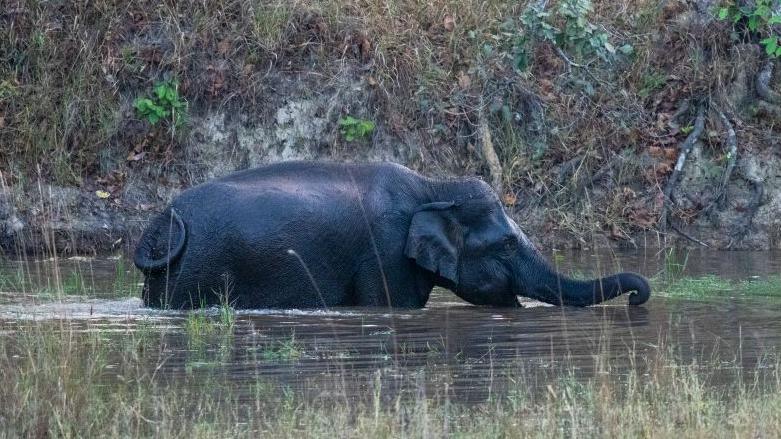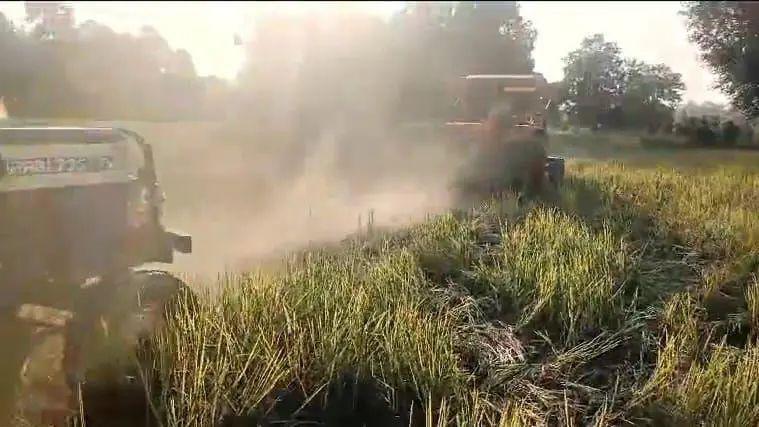Alarm over death of 10 elephants in India national park

An elephant in Bandhavgarh National Park
- Published
The deaths of 10 elephants in three days in a national park in central India has raised alarm among conservationists.
The animals, part of a herd of 13 elephants, died over 29-31 October at the Bandhavgarh National Park in Madhya Pradesh state.
A preliminary toxicology report says that the elephants may have died from eating a millet crop infected with fungus.
The deaths have generated national headlines and criticism, putting the state's government on the back foot.
“[The toxicology report indicates] that the elephants had consumed a large quantity of decayed kodo [millet] plants and grains,” said L Krishna Murthy, a senior forest official who is leading an inquiry into the deaths.
Initial unconfirmed reports said that the elephants had been poisoned, possibly by farmers to stop them destroying crops. But government officials say there is no sign of deliberate poisoning.
The toxicology report says cyclopiazonic acid - a fungal neurotoxin - was found in the samples taken from the dead elephants.
They are thought to have eaten a large amount of kodo millets, which are usually grown in arid regions in countries including India, Pakistan and Philippines and parts of West Africa.
Around 35% of kodo millet produced in India is cultivated in Madhya Pradesh.
The crop grows quickly, can withstand drought conditions and can be stored for long periods. It is also easy to digest, external and has several health benefits.
But some studies, external have found that eating the millet can cause "intoxication and poisoning" as the grains are "frequently infested" with a kind of fungus that produces cyclopiazonic acid.
Another study, external, done by researchers at the Indian Institute of Millets Research, says that while many "crops suffer from [cyclopiazonic acid] contamination, major adverse effects have been recorded only in kodo millet because of lack of scientific management". They also suggest that some practices, such as drying the harvested crop quickly, could ensure it is safe.

Authorities destroyed kodo millet crops near the national park after the deaths
There have been some reported cases of animals dying after eating the crop, though they are not that frequent.
In 1933, 14 elephants died near a forest in the southern state of Tamil Nadu after consuming kodo millets, according to a report, external co-authored by ecologist Raman Sukumar and mycologist TS Suryanarayanan in Down to Earth magazine.
Mr Sukumar, who has worked extensively on the Asian elephant and human–wildlife conflict, told the BBC that elephants frequently eat millets when they enter fields looking for food.
Elephants have a good sense of smell, but mycotoxins are odourless and tasteless.
“My sense is that elephants tried to eat as much as possible in as little time as possible because they knew that farmers would chase them away,” he said.
He adds that weather also likely played a role in the fungal growth on the millets. Days before the deaths, there were heavy rains in the region, producing moist conditions conducive to fungal infection.
After news reports began blaming kodo millets, authorities destroyed some crops in villages close to the national park.
The toxicology report recommends surveying and destroying the residue of the fungus-infected crop and preventing the entry of domestic and wild animals into such fields.
But farmers in the area said that they have been growing kodo millets for years without any adverse events.
Mr Sukumar also says it is still rare for fungal infections to produce mycotoxins in kodo millets.
“The elephants were unfortunate this time,” he says.
Follow BBC News India on Instagram, external, YouTube, external, Twitter, external and Facebook, external